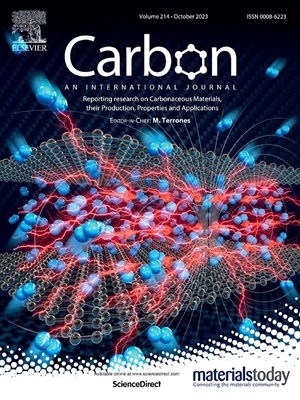Carbon dots inspired upgradable hierarchical carbon for enhanced tetracycline adsorption
IF 10.5
2区 材料科学
Q1 CHEMISTRY, PHYSICAL
引用次数: 0
Abstract
Lignin, a bulk waste byproduct from biorefining processes, possesses complex macromolecular structures that resist dissociation during thermal conversion. However, its propensity for condensation and carbonization makes it suitable for carbon material preparation. Nevertheless, the amorphous nature of lignin causes melting and flow during heating, which covers newly formed pores and results in underdeveloped pore structures in the resulting hierarchical carbons. In this study, an innovative pre-carbonization engineering strategy was proposed to break this barrier. By purposeful re-carbonization, partial lignin macromolecules were induced to form numerous micro-carbon dots, which effectively blocks the melting and flowing of lignin when heating, preventing the covering of newborn pores. The unstable interface between the carbonized phase and the lignin phase provides more active sites for pore development. Characterization results showed that the prepared carbon material exhibited hierarchical pore structure with an extremely high specific surface area. Furthermore, the optimal sample possessed the maximum BET surface area and adsorption capacity for tetracycline as 2246 m2/g and 1196 mg/g, representing 42.77 % and 23.15 % enhancements respectively compared to hierarchical carbon derived from raw lignin. In conclusion, the lignin-based hierarchical carbon material developed in this study provides a simple, economical, and efficient method for the removal of antibiotics in wastewater treatment, contributing to water pollution control.

碳点启发可升级的分层碳增强四环素吸附
木质素是生物精炼过程中产生的大量废物副产品,具有复杂的大分子结构,在热转化过程中不易解离。然而,它的缩合和碳化倾向使其适合于碳材料的制备。然而,木质素的无定形性质导致加热过程中的熔化和流动,这覆盖了新形成的孔隙,导致产生的分层碳的孔隙结构不发达。在本研究中,提出了一种创新的预碳化工程策略来打破这一障碍。通过有目的的再碳化,诱导部分木质素大分子形成大量的微碳点,有效地阻断了木质素在加热时的熔化和流动,防止了新生孔隙的覆盖。炭化相和木质素相之间的不稳定界面为孔隙发育提供了更多的活性位点。表征结果表明,制备的碳材料具有具有极高比表面积的分层孔结构。此外,优化后的样品对四环素的最大BET表面积和吸附量分别为2246 m2/g和1196 mg/g,比原木质素衍生的分层碳分别提高42.77%和23.15%。综上所述,本研究开发的木质素基分层碳材料为废水处理中抗生素的去除提供了一种简单、经济、高效的方法,有助于水污染的控制。
本文章由计算机程序翻译,如有差异,请以英文原文为准。
求助全文
约1分钟内获得全文
求助全文
来源期刊

Carbon
工程技术-材料科学:综合
CiteScore
20.80
自引率
7.30%
发文量
0
审稿时长
23 days
期刊介绍:
The journal Carbon is an international multidisciplinary forum for communicating scientific advances in the field of carbon materials. It reports new findings related to the formation, structure, properties, behaviors, and technological applications of carbons. Carbons are a broad class of ordered or disordered solid phases composed primarily of elemental carbon, including but not limited to carbon black, carbon fibers and filaments, carbon nanotubes, diamond and diamond-like carbon, fullerenes, glassy carbon, graphite, graphene, graphene-oxide, porous carbons, pyrolytic carbon, and other sp2 and non-sp2 hybridized carbon systems. Carbon is the companion title to the open access journal Carbon Trends. Relevant application areas for carbon materials include biology and medicine, catalysis, electronic, optoelectronic, spintronic, high-frequency, and photonic devices, energy storage and conversion systems, environmental applications and water treatment, smart materials and systems, and structural and thermal applications.
 求助内容:
求助内容: 应助结果提醒方式:
应助结果提醒方式:


